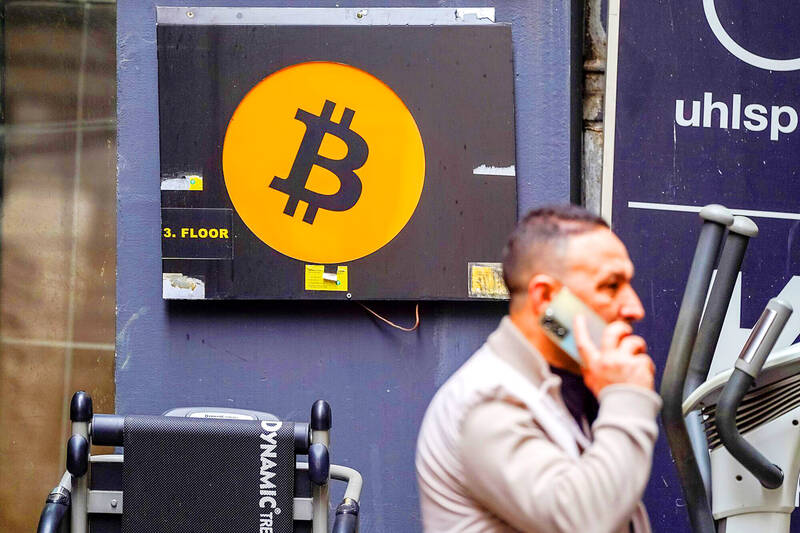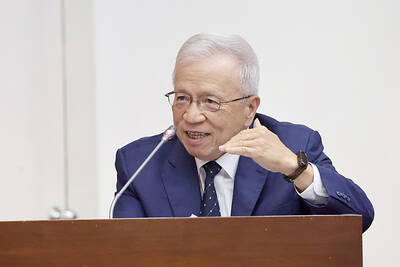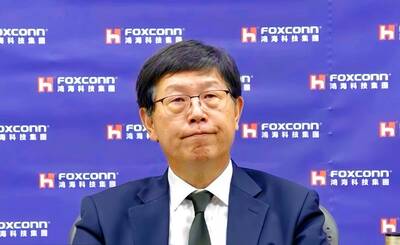About 6,000 older bitcoin mining machines in the US are to soon be idled and sent to a warehouse in Colorado Springs, where they are to be refreshed and resold to buyers overseas looking to profit from mining in lower-cost environments.
Wholesaler SunnySide Digital Inc operates the 3,251 square meter facility taking in the equipment from a mining client. The outdated machines are among several hundred thousand it expects to receive and refurbish around a major quadrennial update in the bitcoin blockchain.
Known as the “halving,” the event in late next month would slash the reward that is the main revenue stream for miners, who would try to lessen the impact by upgrading to the latest and most efficient technology.

Photo: Bloomberg
With electricity the biggest expense, mining companies including publicly traded giants Marathon Digital Holdings Inc and Riot Platforms Inc need to lower usage costs to maintain a positive margin. Their older computers might still bring a profit, just not likely in the US.
“It’s a natural migration” with buyers of the old machines operating in parts of the world where power is the cheapest, said SunnySide Digital chief executive officer Taras Kulyk, who has resold US computers to miners in countries such as Ethiopia, Tanzania, Paraguay and Uruguay.
“This is accelerated by the halving,” he added.
About 600,000 S19 series computers, which account for a majority of machines currently in use, are moving out of the US mostly to Africa and South America, said Ethan Vera, chief operating officer at crypto-mining services and logistics provider Luxor Technology Corp in Seattle.
In bitcoin mining, specialized machines are used to validate transactions on the blockchain and earn operators a fixed token reward. Anonymous bitcoin creator Satoshi Nakamoto baked in the once-every-four-years halving to maintain the hard cap of 21 million tokens.
Next month’s event is the fourth since 2012 and the reward is to drop to 3.125 bitcoin from 6.25 now.
Bitcoin has surged 50 percent this year to about US$63,500, though it is down from a record high of US$73,798 reached on March 14 this year. Bringing more efficient machines online has become more urgent with the halving just weeks away, as continued use of older equipment could mean electricity costs would be close to or exceed mining revenue.
There are miners in the US opting not to sell their hardware and instead transfer the equipment to regions with lower electricity costs and third-party data centers. Nuo Xu (徐諾), who has two sites in Texas, is traveling this month to Ethiopia, Nigeria and a few other countries to scope out locations for about 6,000 older computers.
“There are more risks for my machines in Africa but I have to move them there,” he said. “Cheaper electricity outside the US means it will take a much shorter time to recover the overhead costs,” with labor and building materials also much less expensive, he added.
However, not all US-based equipment leaves the country. That process could be tougher for publicly traded companies because they have to take risk-averse shareholders into account. There is also some hesitation to relocate machines abroad due to transportation costs, breakage and security concerns.
Still, miners have been prepping for the halving for years and are spending big bucks to replace their older hardware. The 13 major public bitcoin-mining companies, including Riot Platforms and CleanSpark Inc, have placed orders for more than US$1 billion worth of machines since February last year, crypto-mining researcher TheMinerMag said.
Five of the biggest miners raised more than US$2.7 billion from selling shares in the two years ended in December last year.
Since the start of this year, those same miners have raked in an additional US$840 million, the researcher said.

JITTERS: Nexperia has a 20 percent market share for chips powering simpler features such as window controls, and changing supply chains could take years European carmakers are looking into ways to scratch components made with parts from China, spooked by deepening geopolitical spats playing out through chipmaker Nexperia BV and Beijing’s export controls on rare earths. To protect operations from trade ructions, several automakers are pushing major suppliers to find permanent alternatives to Chinese semiconductors, people familiar with the matter said. The industry is considering broader changes to its supply chain to adapt to shifting geopolitics, Europe’s main suppliers lobby CLEPA head Matthias Zink said. “We had some indications already — questions like: ‘How can you supply me without this dependency on China?’” Zink, who also

At least US$50 million for the freedom of an Emirati sheikh: That is the king’s ransom paid two weeks ago to militants linked to al-Qaeda who are pushing to topple the Malian government and impose Islamic law. Alongside a crippling fuel blockade, the Group for the Support of Islam and Muslims (JNIM) has made kidnapping wealthy foreigners for a ransom a pillar of its strategy of “economic jihad.” Its goal: Oust the junta, which has struggled to contain Mali’s decade-long insurgency since taking power following back-to-back coups in 2020 and 2021, by scaring away investors and paralyzing the west African country’s economy.

BUST FEARS: While a KMT legislator asked if an AI bubble could affect Taiwan, the DGBAS minister said the sector appears on track to continue growing The local property market has cooled down moderately following a series of credit control measures designed to contain speculation, the central bank said yesterday, while remaining tight-lipped about potential rule relaxations. Lawmakers in a meeting of the legislature’s Finance Committee voiced concerns to central bank officials that the credit control measures have adversely affected the government’s tax income and small and medium-sized property developers, with limited positive effects. Housing prices have been climbing since 2016, even when the central bank imposed its first set of control measures in 2020, Chinese Nationalist Party (KMT) Legislator Lo Ting-wei (羅廷瑋) said. “Since the second half of

AI BOOST: Next year, the cloud and networking product business is expected to remain a key revenue pillar for the company, Hon Hai chairman Young Liu said Manufacturing giant Hon Hai Precision Industry Co (鴻海精密) yesterday posted its best third-quarter profit in the company’s history, backed by strong demand for artificial intelligence (AI) servers. Net profit expanded 17 percent annually to NT$57.67 billion (US$1.86 billion) from NT$44.36 billion, the company said. On a quarterly basis, net profit soared 30 percent from NT$44.36 billion, it said. Hon Hai, which is Apple Inc’s primary iPhone assembler and makes servers powered by Nvidia Corp’s AI accelerators, said earnings per share expanded to NT$4.15 from NT$3.55 a year earlier and NT$3.19 in the second quarter. Gross margin improved to 6.35 percent,